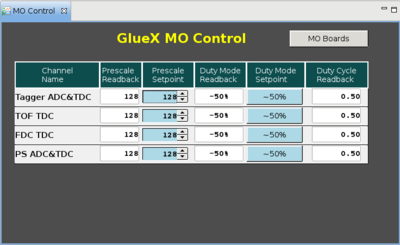Difference between revisions of "RF Signals Shift"
(→RF EPICS GUI Screens) |
|||
| Line 1: | Line 1: | ||
| − | == | + | == RF Master Oscillator Signal == |
| − | The | + | The CEBAF accelerator is controlled by a Master Oscillator Clock running at 1497 MHz, corresponding to 499 MHz (2.004 ns spacing) per hall with 3-hall operation. The precise 499 MHz RF clock is delivered to the tagger and to Hall D to be used for accurate timing of beam bunches arriving to the experimental area. As part of 4-hall operation, the beam is almost always delivered to Hall D at 249.5 MHz with arrival times synchronized to the RF signal provided by accelerator. This clock is too fast for our detector electronics, so we pre-scale the signal by a factor of 128 as input to our electronics 256.51 MHz. The timing of the leading edge of the clock is aligned with the 499 MHz RF signal, but the phase is arbitrary and must be calibrated. |
| − | + | ||
| − | == | + | === RF Initialization === |
| + | [[Image:GlueX MO Control GUI.png | thumb | 400px | Fig. 1. EPICS GUI that controls the pre-scale factors used to create submultiple clocks from the RF master oscillator signal.]] | ||
| − | The | + | The nominal pre-scale factor for the RF signal is 128=16x8, where the two factors correspond to two electronic stages, which are settable with the RF EPICS GUI shown in Fig. 1. Shift personnel should not need to change this, but if the IOC that controls the pre-scale boards is rebooted, these values may need to be restored to values shown in the figure. |
| − | + | ||
| − | + | ||
| − | + | ||
| − | + | ||
| − | + | ||
| − | + | ||
| − | + | ||
== Expert personnel == | == Expert personnel == | ||
Revision as of 16:25, 20 September 2018
RF Master Oscillator Signal
The CEBAF accelerator is controlled by a Master Oscillator Clock running at 1497 MHz, corresponding to 499 MHz (2.004 ns spacing) per hall with 3-hall operation. The precise 499 MHz RF clock is delivered to the tagger and to Hall D to be used for accurate timing of beam bunches arriving to the experimental area. As part of 4-hall operation, the beam is almost always delivered to Hall D at 249.5 MHz with arrival times synchronized to the RF signal provided by accelerator. This clock is too fast for our detector electronics, so we pre-scale the signal by a factor of 128 as input to our electronics 256.51 MHz. The timing of the leading edge of the clock is aligned with the 499 MHz RF signal, but the phase is arbitrary and must be calibrated.
RF Initialization
The nominal pre-scale factor for the RF signal is 128=16x8, where the two factors correspond to two electronic stages, which are settable with the RF EPICS GUI shown in Fig. 1. Shift personnel should not need to change this, but if the IOC that controls the pre-scale boards is rebooted, these values may need to be restored to values shown in the figure.
Expert personnel
The individuals responsible for checking that the RF is ready to take data and setting its operating parameters are shown in following table. Problems with normal operation of the RF signal should be referred to those individuals and any changes to their settings must be approved by them. Additional experts may be trained by the system owner and their name and date added to this table.
| Name | Number | Date of qualification |
|---|---|---|
| Fernando Barbosa (hardware) | JLab: 7433 | Sep 20, 2018 |
| Axxxxx | JLab: 5553 | Sep 20, 2018 |
